Europe's Energy Policy & Strategy: Infrastructure, Investment Analysis
VerifiedAdded on 2023/05/27
|12
|3278
|243
Essay
AI Summary
This essay critically discusses the need for a European Energy Policy and Strategy in light of climate change and the European Union's "20-20-20 by 2020" targets. It highlights Europe's dependence on external energy resources and the political tensions necessitating a sustainable energy approach. The essay analyzes the steps Europe is taking in terms of new infrastructure and investments, including the Energy Union strategy, building infrastructure development, Trans-European Networks for Energy (TEN-E), Projects of Common Interest, and the Energy Infrastructure Forum. It further explores thematic areas like smart grids, electricity highways, and cross-border carbon networks, as well as priority corridors focusing on electricity, gas, and oil. The essay concludes by emphasizing the importance of these measures for achieving energy sustainability and climate goals while fostering growth and jobs within the European Union.
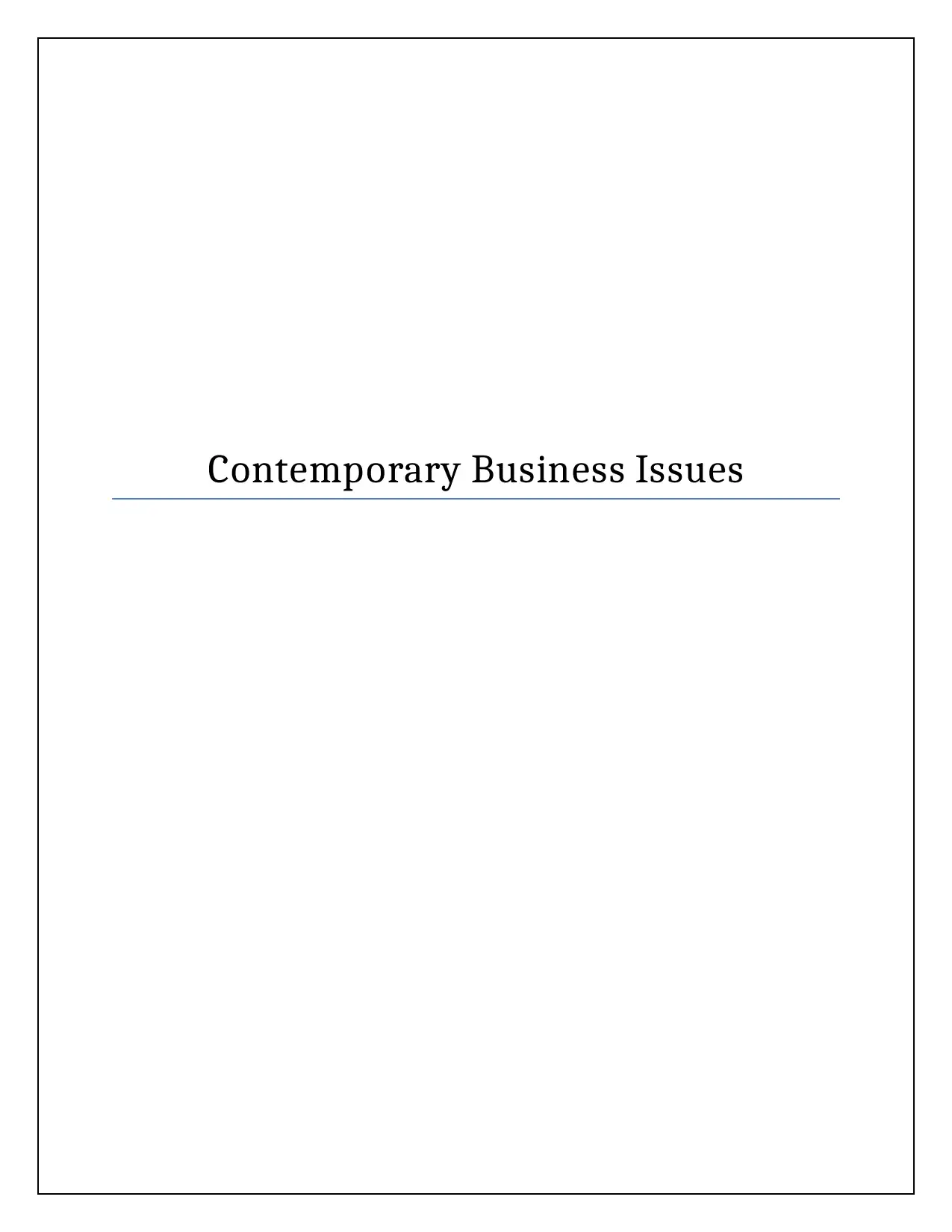
Contemporary Business Issues
Paraphrase This Document
Need a fresh take? Get an instant paraphrase of this document with our AI Paraphraser
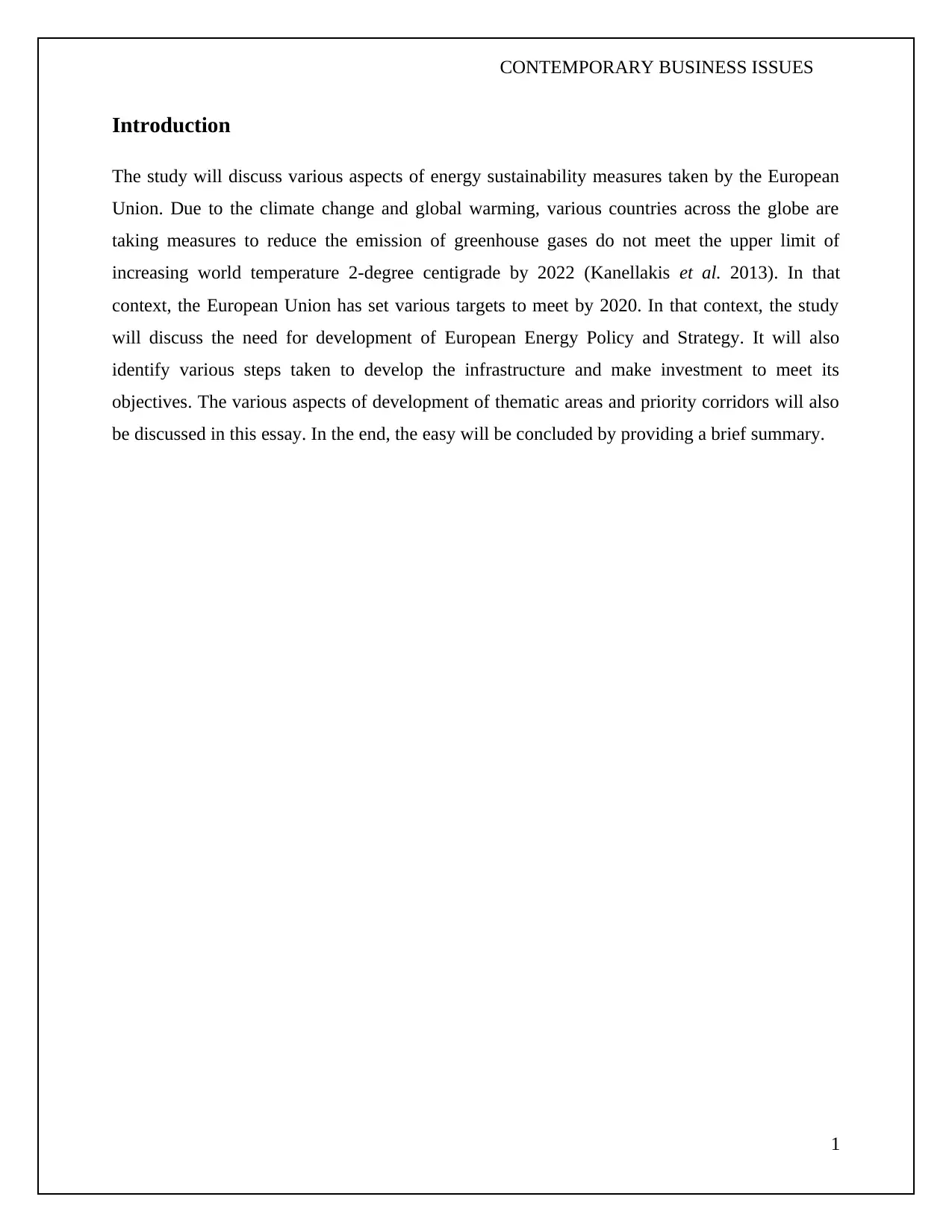
CONTEMPORARY BUSINESS ISSUES
Introduction
The study will discuss various aspects of energy sustainability measures taken by the European
Union. Due to the climate change and global warming, various countries across the globe are
taking measures to reduce the emission of greenhouse gases do not meet the upper limit of
increasing world temperature 2-degree centigrade by 2022 (Kanellakis et al. 2013). In that
context, the European Union has set various targets to meet by 2020. In that context, the study
will discuss the need for development of European Energy Policy and Strategy. It will also
identify various steps taken to develop the infrastructure and make investment to meet its
objectives. The various aspects of development of thematic areas and priority corridors will also
be discussed in this essay. In the end, the easy will be concluded by providing a brief summary.
1
Introduction
The study will discuss various aspects of energy sustainability measures taken by the European
Union. Due to the climate change and global warming, various countries across the globe are
taking measures to reduce the emission of greenhouse gases do not meet the upper limit of
increasing world temperature 2-degree centigrade by 2022 (Kanellakis et al. 2013). In that
context, the European Union has set various targets to meet by 2020. In that context, the study
will discuss the need for development of European Energy Policy and Strategy. It will also
identify various steps taken to develop the infrastructure and make investment to meet its
objectives. The various aspects of development of thematic areas and priority corridors will also
be discussed in this essay. In the end, the easy will be concluded by providing a brief summary.
1
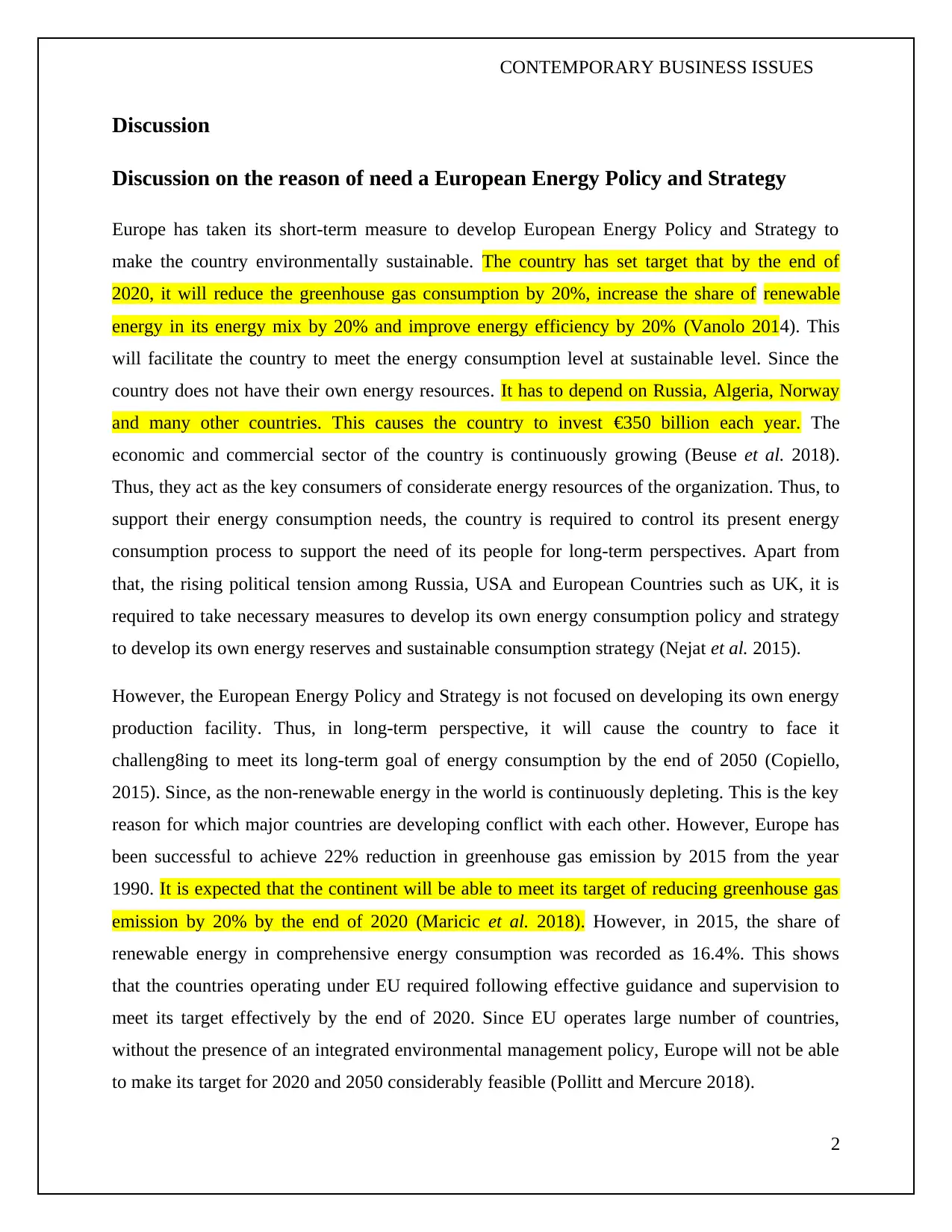
CONTEMPORARY BUSINESS ISSUES
Discussion
Discussion on the reason of need a European Energy Policy and Strategy
Europe has taken its short-term measure to develop European Energy Policy and Strategy to
make the country environmentally sustainable. The country has set target that by the end of
2020, it will reduce the greenhouse gas consumption by 20%, increase the share of renewable
energy in its energy mix by 20% and improve energy efficiency by 20% (Vanolo 2014). This
will facilitate the country to meet the energy consumption level at sustainable level. Since the
country does not have their own energy resources. It has to depend on Russia, Algeria, Norway
and many other countries. This causes the country to invest €350 billion each year. The
economic and commercial sector of the country is continuously growing (Beuse et al. 2018).
Thus, they act as the key consumers of considerate energy resources of the organization. Thus, to
support their energy consumption needs, the country is required to control its present energy
consumption process to support the need of its people for long-term perspectives. Apart from
that, the rising political tension among Russia, USA and European Countries such as UK, it is
required to take necessary measures to develop its own energy consumption policy and strategy
to develop its own energy reserves and sustainable consumption strategy (Nejat et al. 2015).
However, the European Energy Policy and Strategy is not focused on developing its own energy
production facility. Thus, in long-term perspective, it will cause the country to face it
challeng8ing to meet its long-term goal of energy consumption by the end of 2050 (Copiello,
2015). Since, as the non-renewable energy in the world is continuously depleting. This is the key
reason for which major countries are developing conflict with each other. However, Europe has
been successful to achieve 22% reduction in greenhouse gas emission by 2015 from the year
1990. It is expected that the continent will be able to meet its target of reducing greenhouse gas
emission by 20% by the end of 2020 (Maricic et al. 2018). However, in 2015, the share of
renewable energy in comprehensive energy consumption was recorded as 16.4%. This shows
that the countries operating under EU required following effective guidance and supervision to
meet its target effectively by the end of 2020. Since EU operates large number of countries,
without the presence of an integrated environmental management policy, Europe will not be able
to make its target for 2020 and 2050 considerably feasible (Pollitt and Mercure 2018).
2
Discussion
Discussion on the reason of need a European Energy Policy and Strategy
Europe has taken its short-term measure to develop European Energy Policy and Strategy to
make the country environmentally sustainable. The country has set target that by the end of
2020, it will reduce the greenhouse gas consumption by 20%, increase the share of renewable
energy in its energy mix by 20% and improve energy efficiency by 20% (Vanolo 2014). This
will facilitate the country to meet the energy consumption level at sustainable level. Since the
country does not have their own energy resources. It has to depend on Russia, Algeria, Norway
and many other countries. This causes the country to invest €350 billion each year. The
economic and commercial sector of the country is continuously growing (Beuse et al. 2018).
Thus, they act as the key consumers of considerate energy resources of the organization. Thus, to
support their energy consumption needs, the country is required to control its present energy
consumption process to support the need of its people for long-term perspectives. Apart from
that, the rising political tension among Russia, USA and European Countries such as UK, it is
required to take necessary measures to develop its own energy consumption policy and strategy
to develop its own energy reserves and sustainable consumption strategy (Nejat et al. 2015).
However, the European Energy Policy and Strategy is not focused on developing its own energy
production facility. Thus, in long-term perspective, it will cause the country to face it
challeng8ing to meet its long-term goal of energy consumption by the end of 2050 (Copiello,
2015). Since, as the non-renewable energy in the world is continuously depleting. This is the key
reason for which major countries are developing conflict with each other. However, Europe has
been successful to achieve 22% reduction in greenhouse gas emission by 2015 from the year
1990. It is expected that the continent will be able to meet its target of reducing greenhouse gas
emission by 20% by the end of 2020 (Maricic et al. 2018). However, in 2015, the share of
renewable energy in comprehensive energy consumption was recorded as 16.4%. This shows
that the countries operating under EU required following effective guidance and supervision to
meet its target effectively by the end of 2020. Since EU operates large number of countries,
without the presence of an integrated environmental management policy, Europe will not be able
to make its target for 2020 and 2050 considerably feasible (Pollitt and Mercure 2018).
2
⊘ This is a preview!⊘
Do you want full access?
Subscribe today to unlock all pages.

Trusted by 1+ million students worldwide
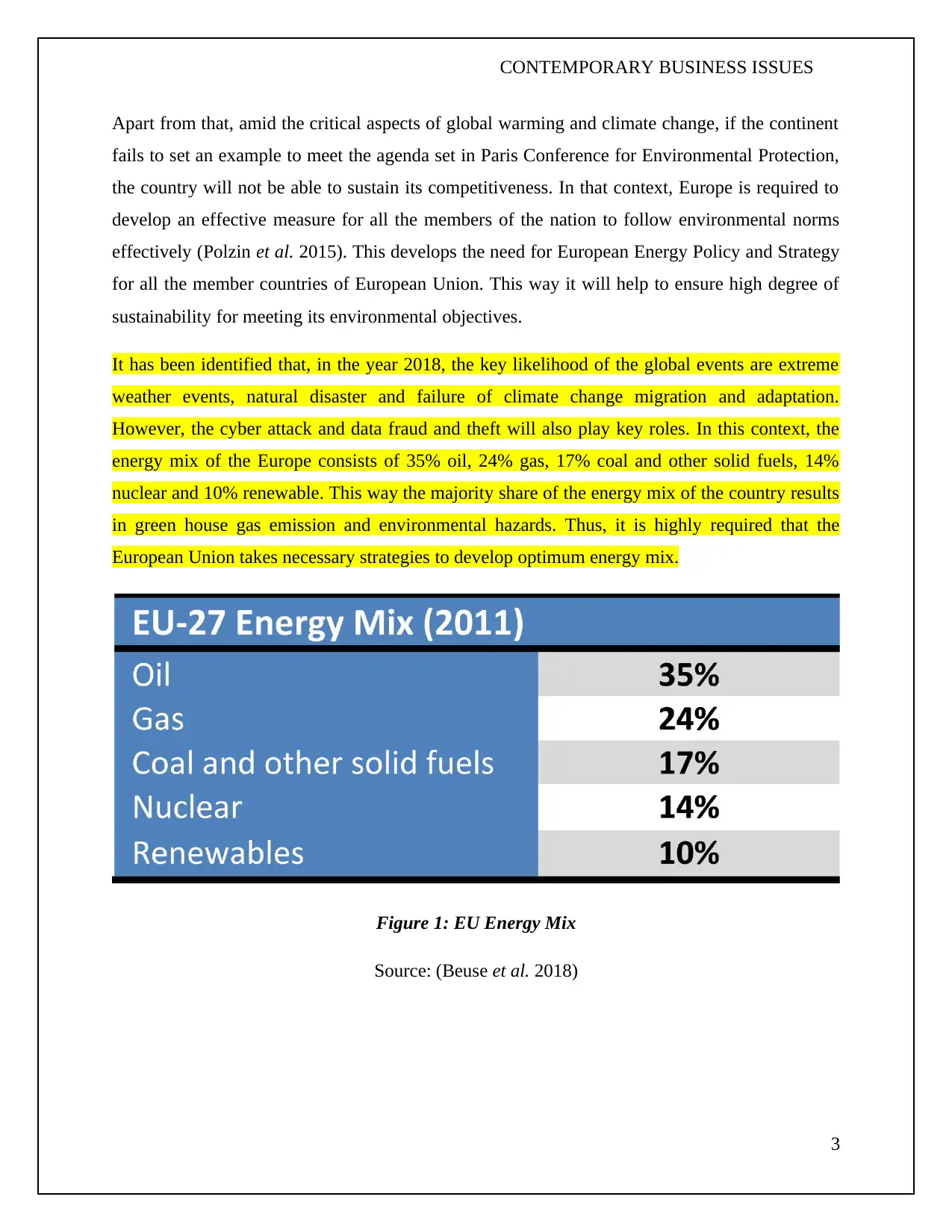
CONTEMPORARY BUSINESS ISSUES
Apart from that, amid the critical aspects of global warming and climate change, if the continent
fails to set an example to meet the agenda set in Paris Conference for Environmental Protection,
the country will not be able to sustain its competitiveness. In that context, Europe is required to
develop an effective measure for all the members of the nation to follow environmental norms
effectively (Polzin et al. 2015). This develops the need for European Energy Policy and Strategy
for all the member countries of European Union. This way it will help to ensure high degree of
sustainability for meeting its environmental objectives.
It has been identified that, in the year 2018, the key likelihood of the global events are extreme
weather events, natural disaster and failure of climate change migration and adaptation.
However, the cyber attack and data fraud and theft will also play key roles. In this context, the
energy mix of the Europe consists of 35% oil, 24% gas, 17% coal and other solid fuels, 14%
nuclear and 10% renewable. This way the majority share of the energy mix of the country results
in green house gas emission and environmental hazards. Thus, it is highly required that the
European Union takes necessary strategies to develop optimum energy mix.
Figure 1: EU Energy Mix
Source: (Beuse et al. 2018)
3
Apart from that, amid the critical aspects of global warming and climate change, if the continent
fails to set an example to meet the agenda set in Paris Conference for Environmental Protection,
the country will not be able to sustain its competitiveness. In that context, Europe is required to
develop an effective measure for all the members of the nation to follow environmental norms
effectively (Polzin et al. 2015). This develops the need for European Energy Policy and Strategy
for all the member countries of European Union. This way it will help to ensure high degree of
sustainability for meeting its environmental objectives.
It has been identified that, in the year 2018, the key likelihood of the global events are extreme
weather events, natural disaster and failure of climate change migration and adaptation.
However, the cyber attack and data fraud and theft will also play key roles. In this context, the
energy mix of the Europe consists of 35% oil, 24% gas, 17% coal and other solid fuels, 14%
nuclear and 10% renewable. This way the majority share of the energy mix of the country results
in green house gas emission and environmental hazards. Thus, it is highly required that the
European Union takes necessary strategies to develop optimum energy mix.
Figure 1: EU Energy Mix
Source: (Beuse et al. 2018)
3
Paraphrase This Document
Need a fresh take? Get an instant paraphrase of this document with our AI Paraphraser
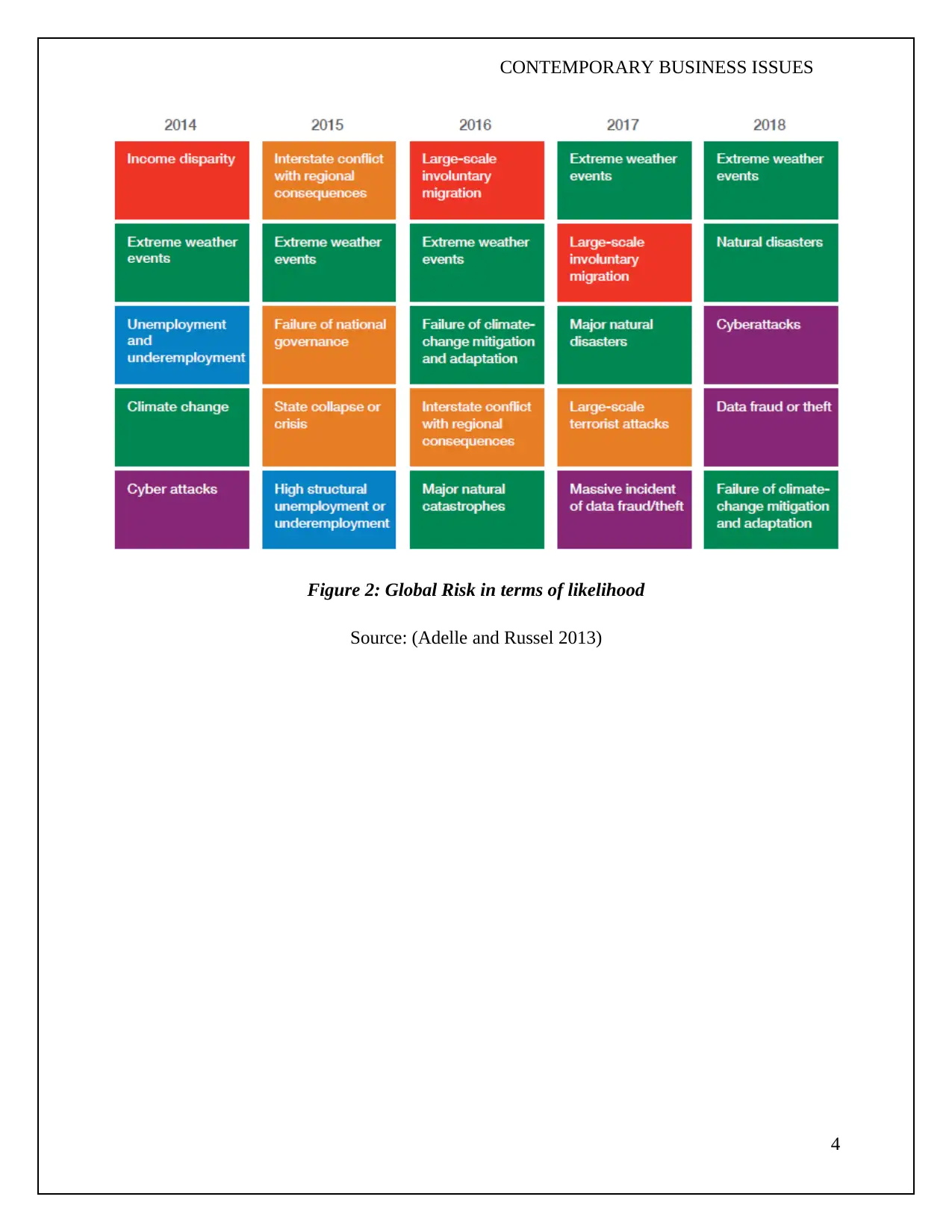
CONTEMPORARY BUSINESS ISSUES
Figure 2: Global Risk in terms of likelihood
Source: (Adelle and Russel 2013)
4
Figure 2: Global Risk in terms of likelihood
Source: (Adelle and Russel 2013)
4
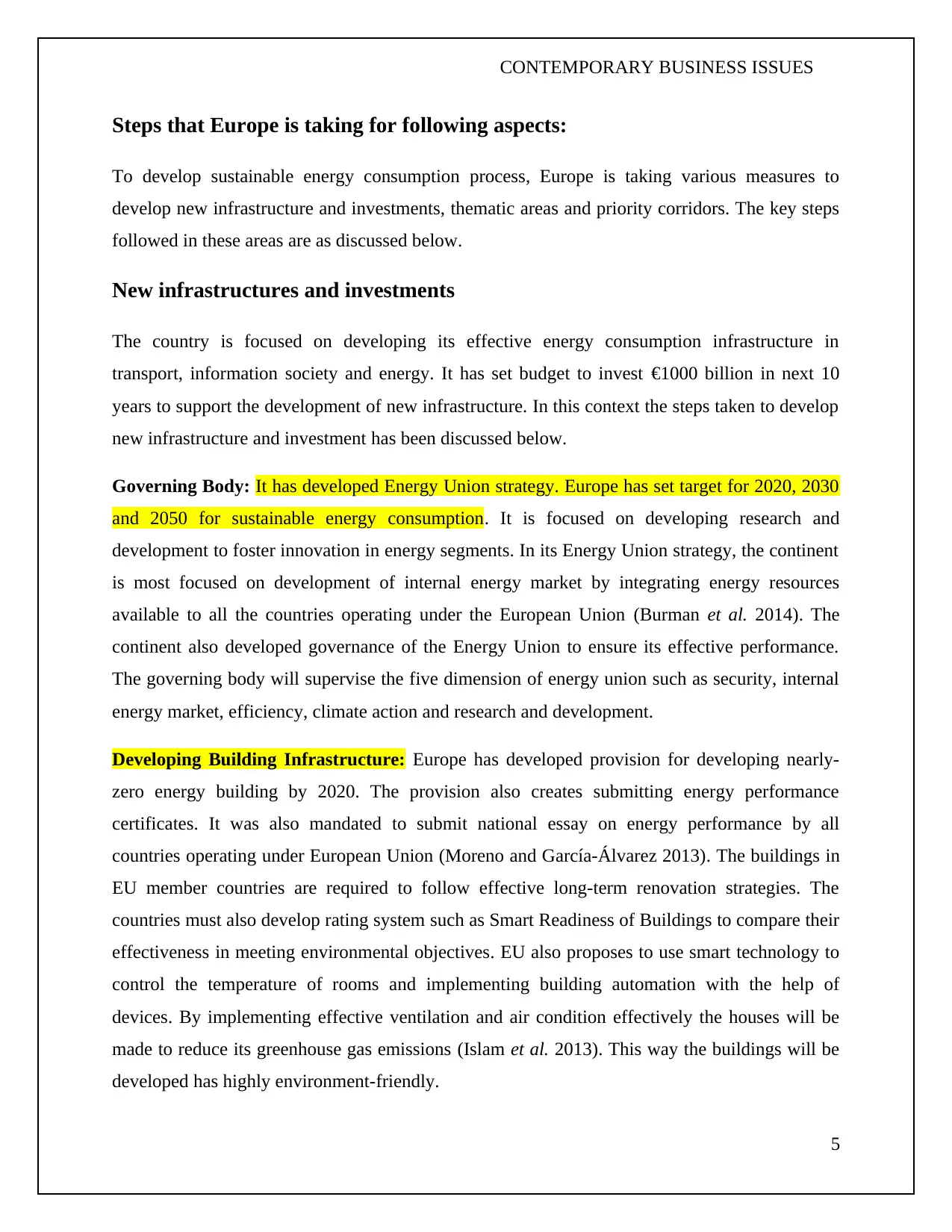
CONTEMPORARY BUSINESS ISSUES
Steps that Europe is taking for following aspects:
To develop sustainable energy consumption process, Europe is taking various measures to
develop new infrastructure and investments, thematic areas and priority corridors. The key steps
followed in these areas are as discussed below.
New infrastructures and investments
The country is focused on developing its effective energy consumption infrastructure in
transport, information society and energy. It has set budget to invest €1000 billion in next 10
years to support the development of new infrastructure. In this context the steps taken to develop
new infrastructure and investment has been discussed below.
Governing Body: It has developed Energy Union strategy. Europe has set target for 2020, 2030
and 2050 for sustainable energy consumption. It is focused on developing research and
development to foster innovation in energy segments. In its Energy Union strategy, the continent
is most focused on development of internal energy market by integrating energy resources
available to all the countries operating under the European Union (Burman et al. 2014). The
continent also developed governance of the Energy Union to ensure its effective performance.
The governing body will supervise the five dimension of energy union such as security, internal
energy market, efficiency, climate action and research and development.
Developing Building Infrastructure: Europe has developed provision for developing nearly-
zero energy building by 2020. The provision also creates submitting energy performance
certificates. It was also mandated to submit national essay on energy performance by all
countries operating under European Union (Moreno and García-Álvarez 2013). The buildings in
EU member countries are required to follow effective long-term renovation strategies. The
countries must also develop rating system such as Smart Readiness of Buildings to compare their
effectiveness in meeting environmental objectives. EU also proposes to use smart technology to
control the temperature of rooms and implementing building automation with the help of
devices. By implementing effective ventilation and air condition effectively the houses will be
made to reduce its greenhouse gas emissions (Islam et al. 2013). This way the buildings will be
developed has highly environment-friendly.
5
Steps that Europe is taking for following aspects:
To develop sustainable energy consumption process, Europe is taking various measures to
develop new infrastructure and investments, thematic areas and priority corridors. The key steps
followed in these areas are as discussed below.
New infrastructures and investments
The country is focused on developing its effective energy consumption infrastructure in
transport, information society and energy. It has set budget to invest €1000 billion in next 10
years to support the development of new infrastructure. In this context the steps taken to develop
new infrastructure and investment has been discussed below.
Governing Body: It has developed Energy Union strategy. Europe has set target for 2020, 2030
and 2050 for sustainable energy consumption. It is focused on developing research and
development to foster innovation in energy segments. In its Energy Union strategy, the continent
is most focused on development of internal energy market by integrating energy resources
available to all the countries operating under the European Union (Burman et al. 2014). The
continent also developed governance of the Energy Union to ensure its effective performance.
The governing body will supervise the five dimension of energy union such as security, internal
energy market, efficiency, climate action and research and development.
Developing Building Infrastructure: Europe has developed provision for developing nearly-
zero energy building by 2020. The provision also creates submitting energy performance
certificates. It was also mandated to submit national essay on energy performance by all
countries operating under European Union (Moreno and García-Álvarez 2013). The buildings in
EU member countries are required to follow effective long-term renovation strategies. The
countries must also develop rating system such as Smart Readiness of Buildings to compare their
effectiveness in meeting environmental objectives. EU also proposes to use smart technology to
control the temperature of rooms and implementing building automation with the help of
devices. By implementing effective ventilation and air condition effectively the houses will be
made to reduce its greenhouse gas emissions (Islam et al. 2013). This way the buildings will be
developed has highly environment-friendly.
5
⊘ This is a preview!⊘
Do you want full access?
Subscribe today to unlock all pages.

Trusted by 1+ million students worldwide
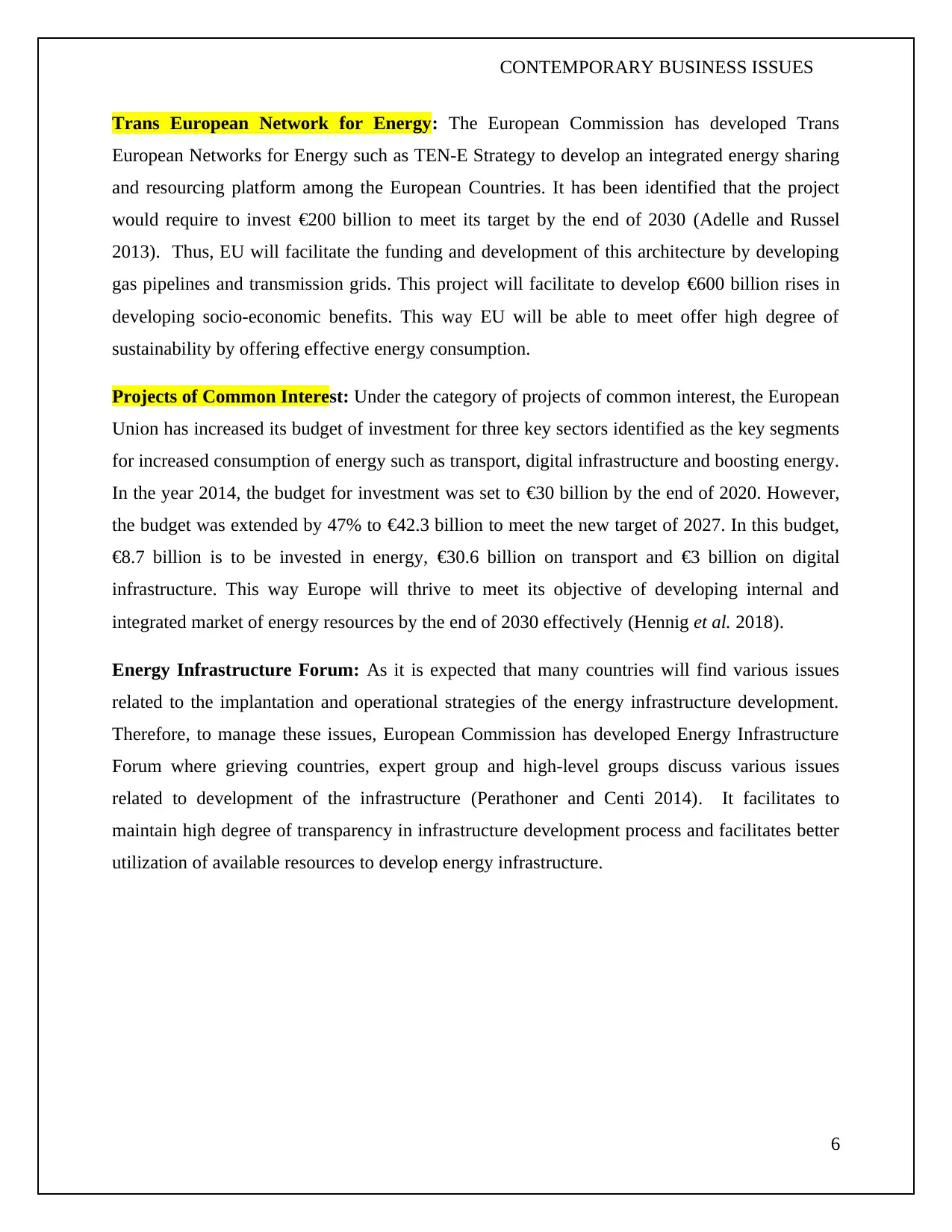
CONTEMPORARY BUSINESS ISSUES
Trans European Network for Energy: The European Commission has developed Trans
European Networks for Energy such as TEN-E Strategy to develop an integrated energy sharing
and resourcing platform among the European Countries. It has been identified that the project
would require to invest €200 billion to meet its target by the end of 2030 (Adelle and Russel
2013). Thus, EU will facilitate the funding and development of this architecture by developing
gas pipelines and transmission grids. This project will facilitate to develop €600 billion rises in
developing socio-economic benefits. This way EU will be able to meet offer high degree of
sustainability by offering effective energy consumption.
Projects of Common Interest: Under the category of projects of common interest, the European
Union has increased its budget of investment for three key sectors identified as the key segments
for increased consumption of energy such as transport, digital infrastructure and boosting energy.
In the year 2014, the budget for investment was set to €30 billion by the end of 2020. However,
the budget was extended by 47% to €42.3 billion to meet the new target of 2027. In this budget,
€8.7 billion is to be invested in energy, €30.6 billion on transport and €3 billion on digital
infrastructure. This way Europe will thrive to meet its objective of developing internal and
integrated market of energy resources by the end of 2030 effectively (Hennig et al. 2018).
Energy Infrastructure Forum: As it is expected that many countries will find various issues
related to the implantation and operational strategies of the energy infrastructure development.
Therefore, to manage these issues, European Commission has developed Energy Infrastructure
Forum where grieving countries, expert group and high-level groups discuss various issues
related to development of the infrastructure (Perathoner and Centi 2014). It facilitates to
maintain high degree of transparency in infrastructure development process and facilitates better
utilization of available resources to develop energy infrastructure.
6
Trans European Network for Energy: The European Commission has developed Trans
European Networks for Energy such as TEN-E Strategy to develop an integrated energy sharing
and resourcing platform among the European Countries. It has been identified that the project
would require to invest €200 billion to meet its target by the end of 2030 (Adelle and Russel
2013). Thus, EU will facilitate the funding and development of this architecture by developing
gas pipelines and transmission grids. This project will facilitate to develop €600 billion rises in
developing socio-economic benefits. This way EU will be able to meet offer high degree of
sustainability by offering effective energy consumption.
Projects of Common Interest: Under the category of projects of common interest, the European
Union has increased its budget of investment for three key sectors identified as the key segments
for increased consumption of energy such as transport, digital infrastructure and boosting energy.
In the year 2014, the budget for investment was set to €30 billion by the end of 2020. However,
the budget was extended by 47% to €42.3 billion to meet the new target of 2027. In this budget,
€8.7 billion is to be invested in energy, €30.6 billion on transport and €3 billion on digital
infrastructure. This way Europe will thrive to meet its objective of developing internal and
integrated market of energy resources by the end of 2030 effectively (Hennig et al. 2018).
Energy Infrastructure Forum: As it is expected that many countries will find various issues
related to the implantation and operational strategies of the energy infrastructure development.
Therefore, to manage these issues, European Commission has developed Energy Infrastructure
Forum where grieving countries, expert group and high-level groups discuss various issues
related to development of the infrastructure (Perathoner and Centi 2014). It facilitates to
maintain high degree of transparency in infrastructure development process and facilitates better
utilization of available resources to develop energy infrastructure.
6
Paraphrase This Document
Need a fresh take? Get an instant paraphrase of this document with our AI Paraphraser
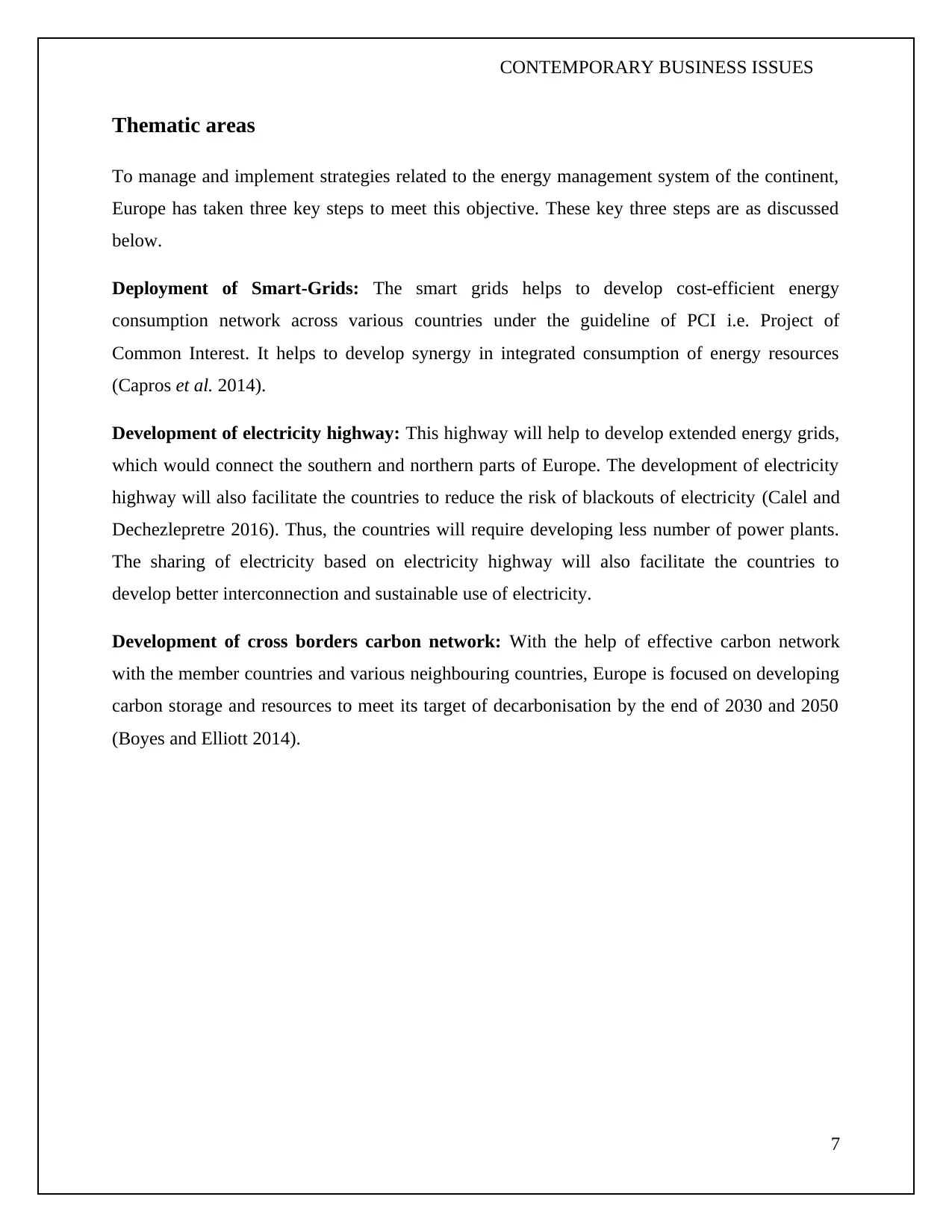
CONTEMPORARY BUSINESS ISSUES
Thematic areas
To manage and implement strategies related to the energy management system of the continent,
Europe has taken three key steps to meet this objective. These key three steps are as discussed
below.
Deployment of Smart-Grids: The smart grids helps to develop cost-efficient energy
consumption network across various countries under the guideline of PCI i.e. Project of
Common Interest. It helps to develop synergy in integrated consumption of energy resources
(Capros et al. 2014).
Development of electricity highway: This highway will help to develop extended energy grids,
which would connect the southern and northern parts of Europe. The development of electricity
highway will also facilitate the countries to reduce the risk of blackouts of electricity (Calel and
Dechezlepretre 2016). Thus, the countries will require developing less number of power plants.
The sharing of electricity based on electricity highway will also facilitate the countries to
develop better interconnection and sustainable use of electricity.
Development of cross borders carbon network: With the help of effective carbon network
with the member countries and various neighbouring countries, Europe is focused on developing
carbon storage and resources to meet its target of decarbonisation by the end of 2030 and 2050
(Boyes and Elliott 2014).
7
Thematic areas
To manage and implement strategies related to the energy management system of the continent,
Europe has taken three key steps to meet this objective. These key three steps are as discussed
below.
Deployment of Smart-Grids: The smart grids helps to develop cost-efficient energy
consumption network across various countries under the guideline of PCI i.e. Project of
Common Interest. It helps to develop synergy in integrated consumption of energy resources
(Capros et al. 2014).
Development of electricity highway: This highway will help to develop extended energy grids,
which would connect the southern and northern parts of Europe. The development of electricity
highway will also facilitate the countries to reduce the risk of blackouts of electricity (Calel and
Dechezlepretre 2016). Thus, the countries will require developing less number of power plants.
The sharing of electricity based on electricity highway will also facilitate the countries to
develop better interconnection and sustainable use of electricity.
Development of cross borders carbon network: With the help of effective carbon network
with the member countries and various neighbouring countries, Europe is focused on developing
carbon storage and resources to meet its target of decarbonisation by the end of 2030 and 2050
(Boyes and Elliott 2014).
7
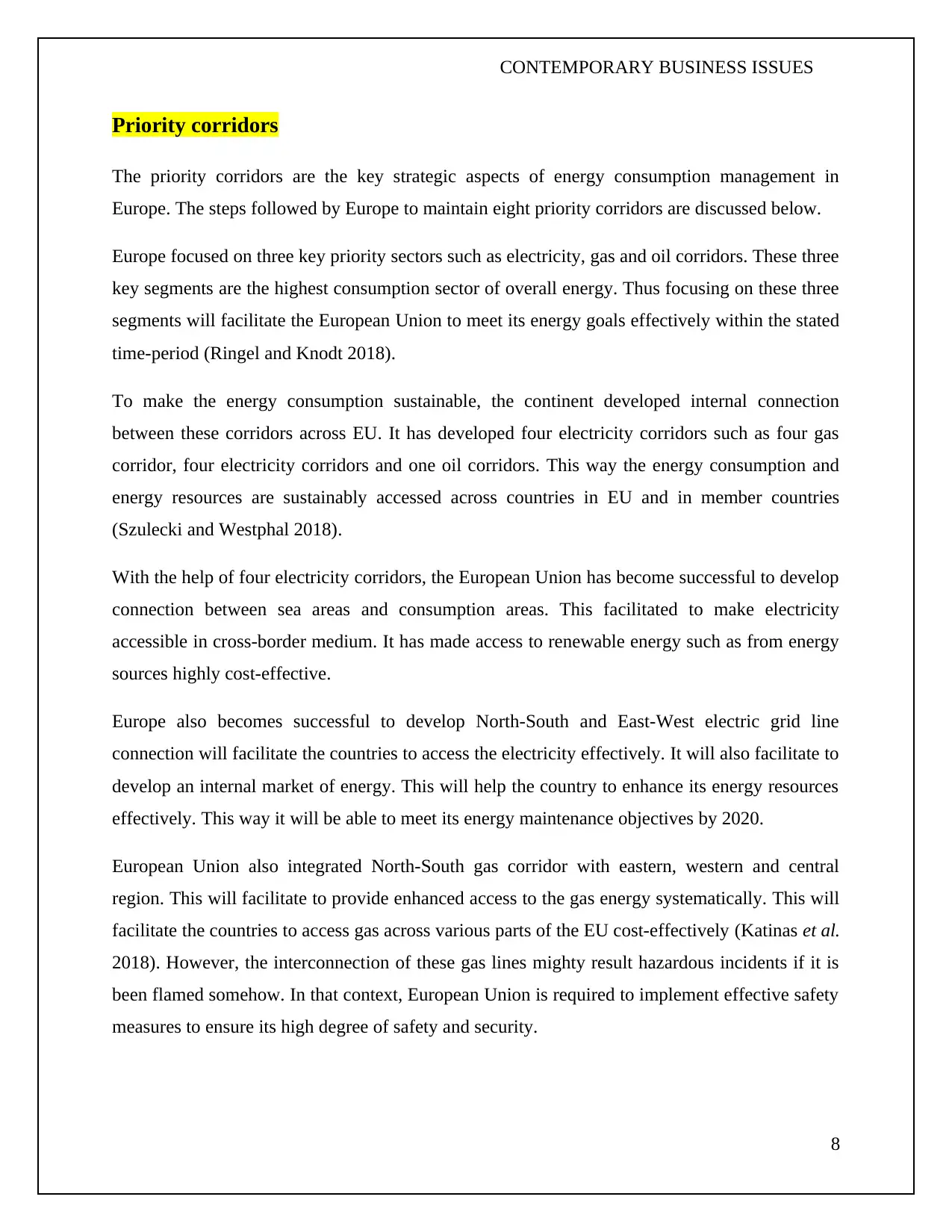
CONTEMPORARY BUSINESS ISSUES
Priority corridors
The priority corridors are the key strategic aspects of energy consumption management in
Europe. The steps followed by Europe to maintain eight priority corridors are discussed below.
Europe focused on three key priority sectors such as electricity, gas and oil corridors. These three
key segments are the highest consumption sector of overall energy. Thus focusing on these three
segments will facilitate the European Union to meet its energy goals effectively within the stated
time-period (Ringel and Knodt 2018).
To make the energy consumption sustainable, the continent developed internal connection
between these corridors across EU. It has developed four electricity corridors such as four gas
corridor, four electricity corridors and one oil corridors. This way the energy consumption and
energy resources are sustainably accessed across countries in EU and in member countries
(Szulecki and Westphal 2018).
With the help of four electricity corridors, the European Union has become successful to develop
connection between sea areas and consumption areas. This facilitated to make electricity
accessible in cross-border medium. It has made access to renewable energy such as from energy
sources highly cost-effective.
Europe also becomes successful to develop North-South and East-West electric grid line
connection will facilitate the countries to access the electricity effectively. It will also facilitate to
develop an internal market of energy. This will help the country to enhance its energy resources
effectively. This way it will be able to meet its energy maintenance objectives by 2020.
European Union also integrated North-South gas corridor with eastern, western and central
region. This will facilitate to provide enhanced access to the gas energy systematically. This will
facilitate the countries to access gas across various parts of the EU cost-effectively (Katinas et al.
2018). However, the interconnection of these gas lines mighty result hazardous incidents if it is
been flamed somehow. In that context, European Union is required to implement effective safety
measures to ensure its high degree of safety and security.
8
Priority corridors
The priority corridors are the key strategic aspects of energy consumption management in
Europe. The steps followed by Europe to maintain eight priority corridors are discussed below.
Europe focused on three key priority sectors such as electricity, gas and oil corridors. These three
key segments are the highest consumption sector of overall energy. Thus focusing on these three
segments will facilitate the European Union to meet its energy goals effectively within the stated
time-period (Ringel and Knodt 2018).
To make the energy consumption sustainable, the continent developed internal connection
between these corridors across EU. It has developed four electricity corridors such as four gas
corridor, four electricity corridors and one oil corridors. This way the energy consumption and
energy resources are sustainably accessed across countries in EU and in member countries
(Szulecki and Westphal 2018).
With the help of four electricity corridors, the European Union has become successful to develop
connection between sea areas and consumption areas. This facilitated to make electricity
accessible in cross-border medium. It has made access to renewable energy such as from energy
sources highly cost-effective.
Europe also becomes successful to develop North-South and East-West electric grid line
connection will facilitate the countries to access the electricity effectively. It will also facilitate to
develop an internal market of energy. This will help the country to enhance its energy resources
effectively. This way it will be able to meet its energy maintenance objectives by 2020.
European Union also integrated North-South gas corridor with eastern, western and central
region. This will facilitate to provide enhanced access to the gas energy systematically. This will
facilitate the countries to access gas across various parts of the EU cost-effectively (Katinas et al.
2018). However, the interconnection of these gas lines mighty result hazardous incidents if it is
been flamed somehow. In that context, European Union is required to implement effective safety
measures to ensure its high degree of safety and security.
8
⊘ This is a preview!⊘
Do you want full access?
Subscribe today to unlock all pages.

Trusted by 1+ million students worldwide
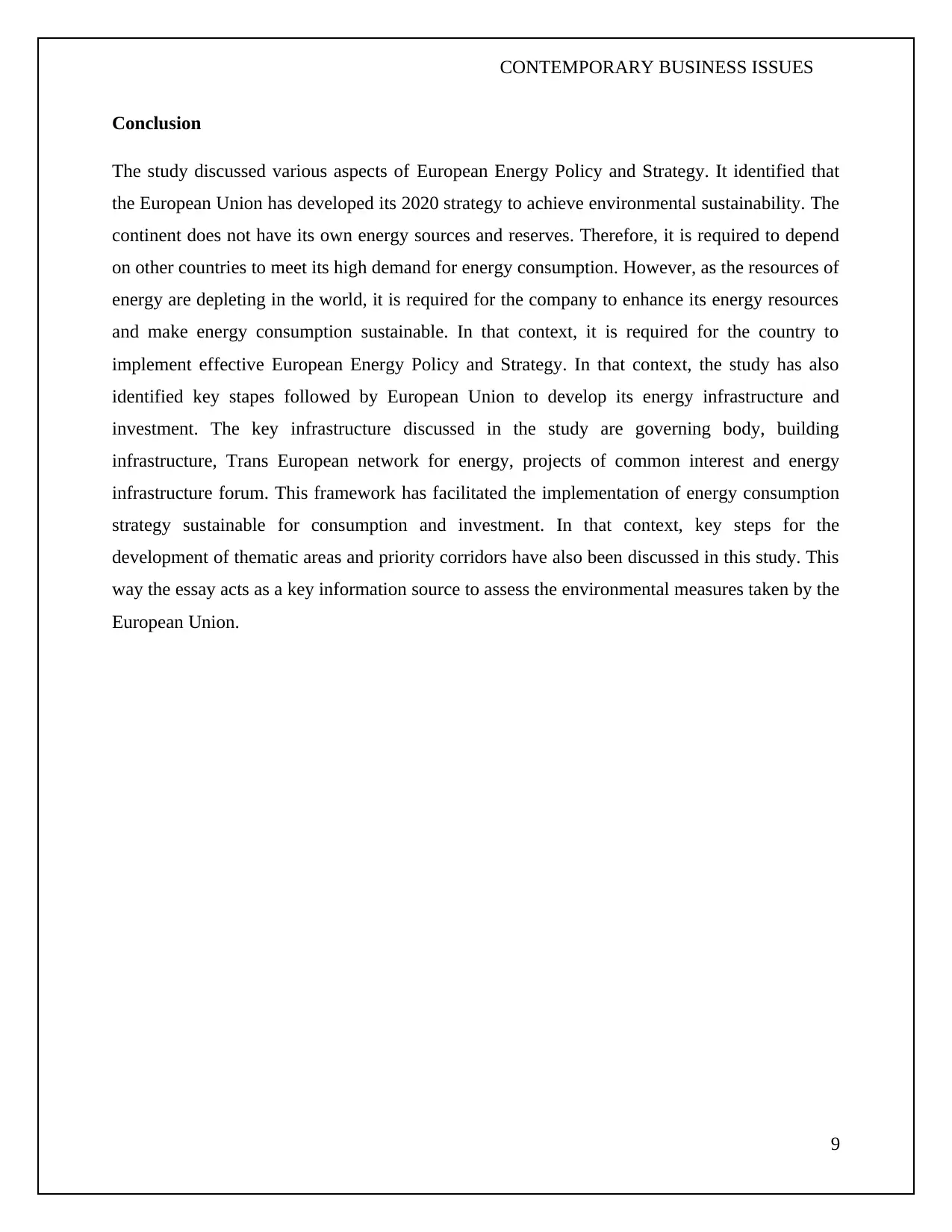
CONTEMPORARY BUSINESS ISSUES
Conclusion
The study discussed various aspects of European Energy Policy and Strategy. It identified that
the European Union has developed its 2020 strategy to achieve environmental sustainability. The
continent does not have its own energy sources and reserves. Therefore, it is required to depend
on other countries to meet its high demand for energy consumption. However, as the resources of
energy are depleting in the world, it is required for the company to enhance its energy resources
and make energy consumption sustainable. In that context, it is required for the country to
implement effective European Energy Policy and Strategy. In that context, the study has also
identified key stapes followed by European Union to develop its energy infrastructure and
investment. The key infrastructure discussed in the study are governing body, building
infrastructure, Trans European network for energy, projects of common interest and energy
infrastructure forum. This framework has facilitated the implementation of energy consumption
strategy sustainable for consumption and investment. In that context, key steps for the
development of thematic areas and priority corridors have also been discussed in this study. This
way the essay acts as a key information source to assess the environmental measures taken by the
European Union.
9
Conclusion
The study discussed various aspects of European Energy Policy and Strategy. It identified that
the European Union has developed its 2020 strategy to achieve environmental sustainability. The
continent does not have its own energy sources and reserves. Therefore, it is required to depend
on other countries to meet its high demand for energy consumption. However, as the resources of
energy are depleting in the world, it is required for the company to enhance its energy resources
and make energy consumption sustainable. In that context, it is required for the country to
implement effective European Energy Policy and Strategy. In that context, the study has also
identified key stapes followed by European Union to develop its energy infrastructure and
investment. The key infrastructure discussed in the study are governing body, building
infrastructure, Trans European network for energy, projects of common interest and energy
infrastructure forum. This framework has facilitated the implementation of energy consumption
strategy sustainable for consumption and investment. In that context, key steps for the
development of thematic areas and priority corridors have also been discussed in this study. This
way the essay acts as a key information source to assess the environmental measures taken by the
European Union.
9
Paraphrase This Document
Need a fresh take? Get an instant paraphrase of this document with our AI Paraphraser
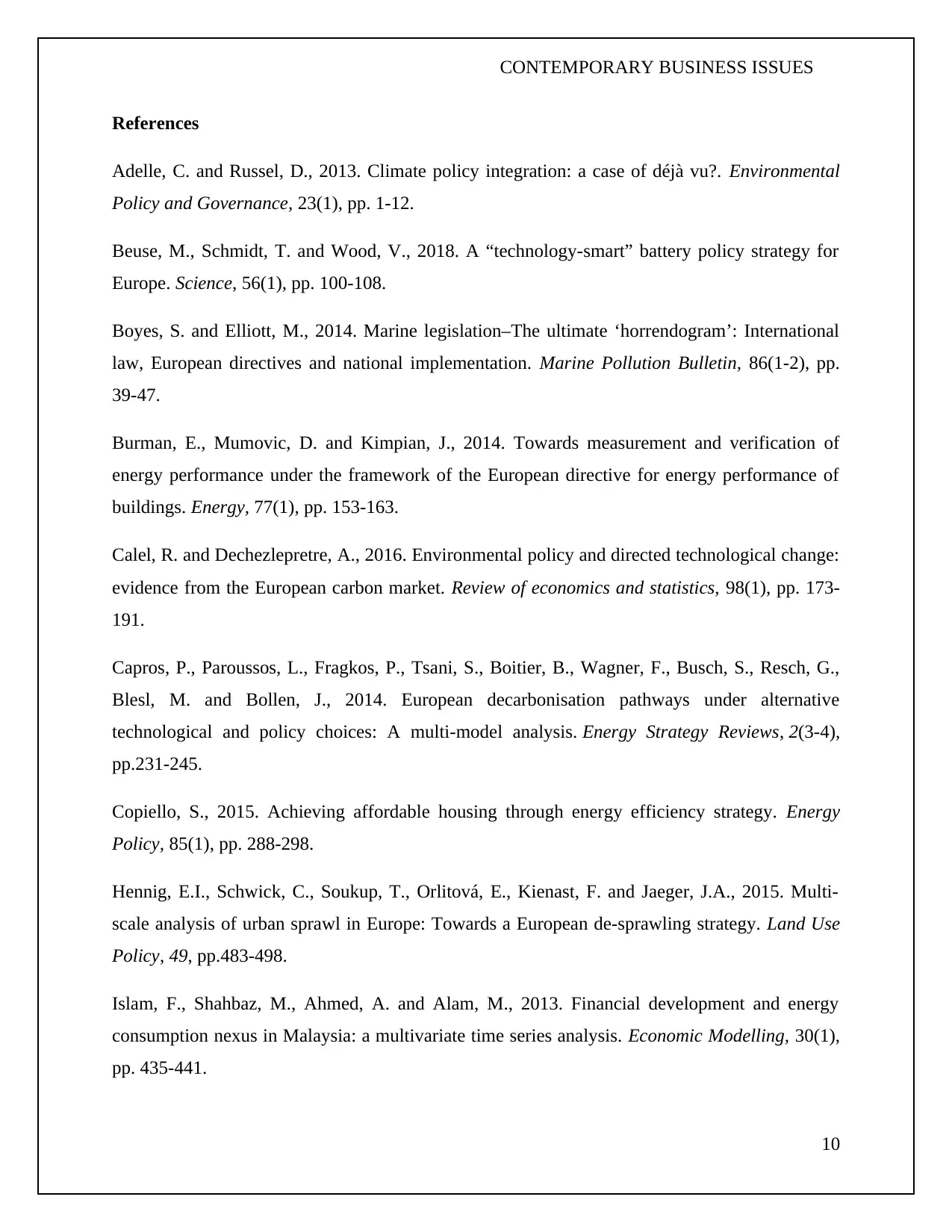
CONTEMPORARY BUSINESS ISSUES
References
Adelle, C. and Russel, D., 2013. Climate policy integration: a case of déjà vu?. Environmental
Policy and Governance, 23(1), pp. 1-12.
Beuse, M., Schmidt, T. and Wood, V., 2018. A “technology-smart” battery policy strategy for
Europe. Science, 56(1), pp. 100-108.
Boyes, S. and Elliott, M., 2014. Marine legislation–The ultimate ‘horrendogram’: International
law, European directives and national implementation. Marine Pollution Bulletin, 86(1-2), pp.
39-47.
Burman, E., Mumovic, D. and Kimpian, J., 2014. Towards measurement and verification of
energy performance under the framework of the European directive for energy performance of
buildings. Energy, 77(1), pp. 153-163.
Calel, R. and Dechezlepretre, A., 2016. Environmental policy and directed technological change:
evidence from the European carbon market. Review of economics and statistics, 98(1), pp. 173-
191.
Capros, P., Paroussos, L., Fragkos, P., Tsani, S., Boitier, B., Wagner, F., Busch, S., Resch, G.,
Blesl, M. and Bollen, J., 2014. European decarbonisation pathways under alternative
technological and policy choices: A multi-model analysis. Energy Strategy Reviews, 2(3-4),
pp.231-245.
Copiello, S., 2015. Achieving affordable housing through energy efficiency strategy. Energy
Policy, 85(1), pp. 288-298.
Hennig, E.I., Schwick, C., Soukup, T., Orlitová, E., Kienast, F. and Jaeger, J.A., 2015. Multi-
scale analysis of urban sprawl in Europe: Towards a European de-sprawling strategy. Land Use
Policy, 49, pp.483-498.
Islam, F., Shahbaz, M., Ahmed, A. and Alam, M., 2013. Financial development and energy
consumption nexus in Malaysia: a multivariate time series analysis. Economic Modelling, 30(1),
pp. 435-441.
10
References
Adelle, C. and Russel, D., 2013. Climate policy integration: a case of déjà vu?. Environmental
Policy and Governance, 23(1), pp. 1-12.
Beuse, M., Schmidt, T. and Wood, V., 2018. A “technology-smart” battery policy strategy for
Europe. Science, 56(1), pp. 100-108.
Boyes, S. and Elliott, M., 2014. Marine legislation–The ultimate ‘horrendogram’: International
law, European directives and national implementation. Marine Pollution Bulletin, 86(1-2), pp.
39-47.
Burman, E., Mumovic, D. and Kimpian, J., 2014. Towards measurement and verification of
energy performance under the framework of the European directive for energy performance of
buildings. Energy, 77(1), pp. 153-163.
Calel, R. and Dechezlepretre, A., 2016. Environmental policy and directed technological change:
evidence from the European carbon market. Review of economics and statistics, 98(1), pp. 173-
191.
Capros, P., Paroussos, L., Fragkos, P., Tsani, S., Boitier, B., Wagner, F., Busch, S., Resch, G.,
Blesl, M. and Bollen, J., 2014. European decarbonisation pathways under alternative
technological and policy choices: A multi-model analysis. Energy Strategy Reviews, 2(3-4),
pp.231-245.
Copiello, S., 2015. Achieving affordable housing through energy efficiency strategy. Energy
Policy, 85(1), pp. 288-298.
Hennig, E.I., Schwick, C., Soukup, T., Orlitová, E., Kienast, F. and Jaeger, J.A., 2015. Multi-
scale analysis of urban sprawl in Europe: Towards a European de-sprawling strategy. Land Use
Policy, 49, pp.483-498.
Islam, F., Shahbaz, M., Ahmed, A. and Alam, M., 2013. Financial development and energy
consumption nexus in Malaysia: a multivariate time series analysis. Economic Modelling, 30(1),
pp. 435-441.
10
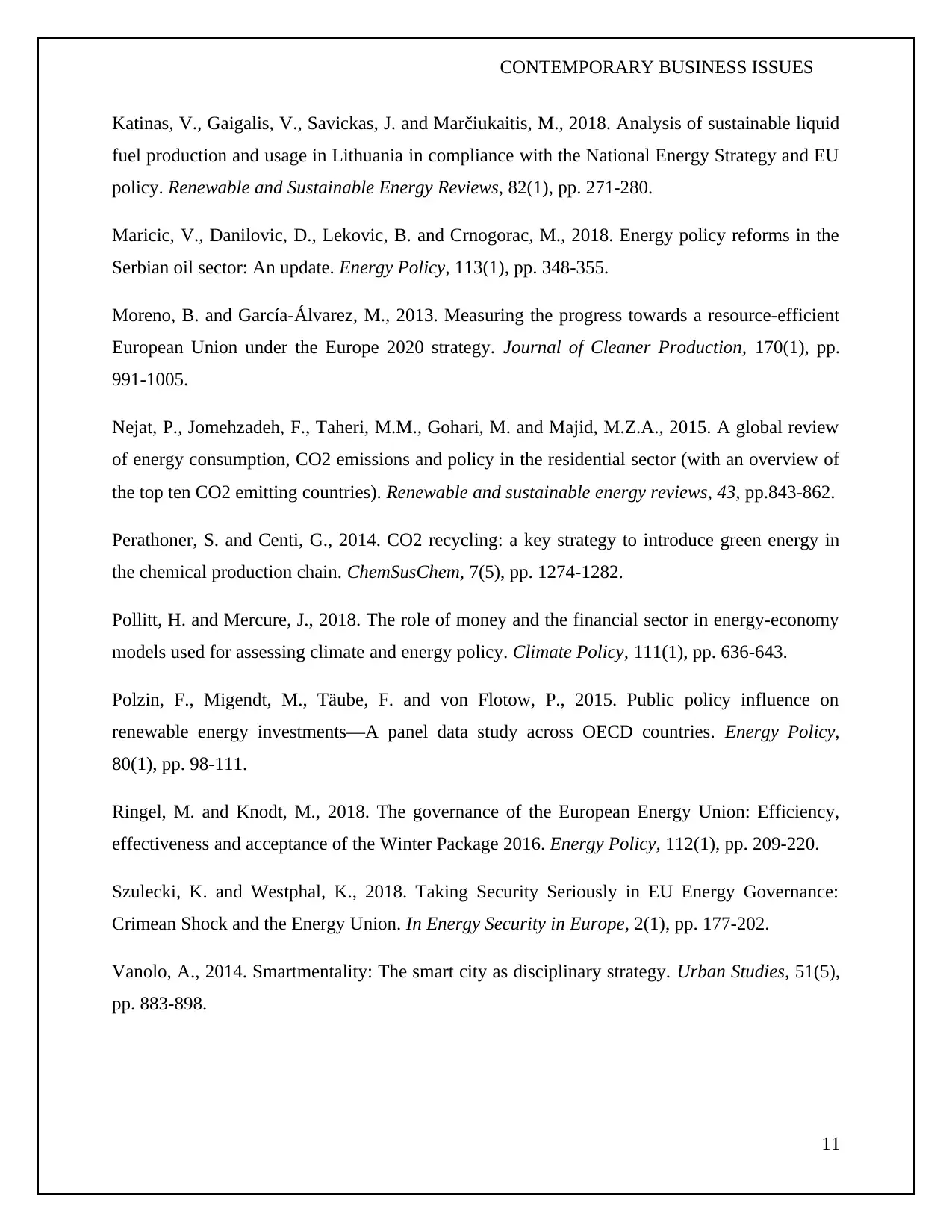
CONTEMPORARY BUSINESS ISSUES
Katinas, V., Gaigalis, V., Savickas, J. and Marčiukaitis, M., 2018. Analysis of sustainable liquid
fuel production and usage in Lithuania in compliance with the National Energy Strategy and EU
policy. Renewable and Sustainable Energy Reviews, 82(1), pp. 271-280.
Maricic, V., Danilovic, D., Lekovic, B. and Crnogorac, M., 2018. Energy policy reforms in the
Serbian oil sector: An update. Energy Policy, 113(1), pp. 348-355.
Moreno, B. and García-Álvarez, M., 2013. Measuring the progress towards a resource-efficient
European Union under the Europe 2020 strategy. Journal of Cleaner Production, 170(1), pp.
991-1005.
Nejat, P., Jomehzadeh, F., Taheri, M.M., Gohari, M. and Majid, M.Z.A., 2015. A global review
of energy consumption, CO2 emissions and policy in the residential sector (with an overview of
the top ten CO2 emitting countries). Renewable and sustainable energy reviews, 43, pp.843-862.
Perathoner, S. and Centi, G., 2014. CO2 recycling: a key strategy to introduce green energy in
the chemical production chain. ChemSusChem, 7(5), pp. 1274-1282.
Pollitt, H. and Mercure, J., 2018. The role of money and the financial sector in energy-economy
models used for assessing climate and energy policy. Climate Policy, 111(1), pp. 636-643.
Polzin, F., Migendt, M., Täube, F. and von Flotow, P., 2015. Public policy influence on
renewable energy investments—A panel data study across OECD countries. Energy Policy,
80(1), pp. 98-111.
Ringel, M. and Knodt, M., 2018. The governance of the European Energy Union: Efficiency,
effectiveness and acceptance of the Winter Package 2016. Energy Policy, 112(1), pp. 209-220.
Szulecki, K. and Westphal, K., 2018. Taking Security Seriously in EU Energy Governance:
Crimean Shock and the Energy Union. In Energy Security in Europe, 2(1), pp. 177-202.
Vanolo, A., 2014. Smartmentality: The smart city as disciplinary strategy. Urban Studies, 51(5),
pp. 883-898.
11
Katinas, V., Gaigalis, V., Savickas, J. and Marčiukaitis, M., 2018. Analysis of sustainable liquid
fuel production and usage in Lithuania in compliance with the National Energy Strategy and EU
policy. Renewable and Sustainable Energy Reviews, 82(1), pp. 271-280.
Maricic, V., Danilovic, D., Lekovic, B. and Crnogorac, M., 2018. Energy policy reforms in the
Serbian oil sector: An update. Energy Policy, 113(1), pp. 348-355.
Moreno, B. and García-Álvarez, M., 2013. Measuring the progress towards a resource-efficient
European Union under the Europe 2020 strategy. Journal of Cleaner Production, 170(1), pp.
991-1005.
Nejat, P., Jomehzadeh, F., Taheri, M.M., Gohari, M. and Majid, M.Z.A., 2015. A global review
of energy consumption, CO2 emissions and policy in the residential sector (with an overview of
the top ten CO2 emitting countries). Renewable and sustainable energy reviews, 43, pp.843-862.
Perathoner, S. and Centi, G., 2014. CO2 recycling: a key strategy to introduce green energy in
the chemical production chain. ChemSusChem, 7(5), pp. 1274-1282.
Pollitt, H. and Mercure, J., 2018. The role of money and the financial sector in energy-economy
models used for assessing climate and energy policy. Climate Policy, 111(1), pp. 636-643.
Polzin, F., Migendt, M., Täube, F. and von Flotow, P., 2015. Public policy influence on
renewable energy investments—A panel data study across OECD countries. Energy Policy,
80(1), pp. 98-111.
Ringel, M. and Knodt, M., 2018. The governance of the European Energy Union: Efficiency,
effectiveness and acceptance of the Winter Package 2016. Energy Policy, 112(1), pp. 209-220.
Szulecki, K. and Westphal, K., 2018. Taking Security Seriously in EU Energy Governance:
Crimean Shock and the Energy Union. In Energy Security in Europe, 2(1), pp. 177-202.
Vanolo, A., 2014. Smartmentality: The smart city as disciplinary strategy. Urban Studies, 51(5),
pp. 883-898.
11
⊘ This is a preview!⊘
Do you want full access?
Subscribe today to unlock all pages.

Trusted by 1+ million students worldwide
1 out of 12
Related Documents
Your All-in-One AI-Powered Toolkit for Academic Success.
+13062052269
info@desklib.com
Available 24*7 on WhatsApp / Email
![[object Object]](/_next/static/media/star-bottom.7253800d.svg)
Unlock your academic potential
Copyright © 2020–2025 A2Z Services. All Rights Reserved. Developed and managed by ZUCOL.




